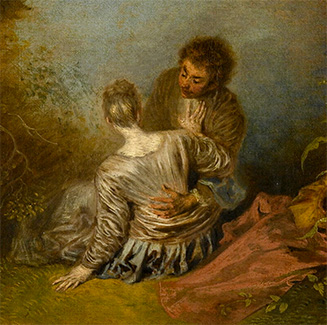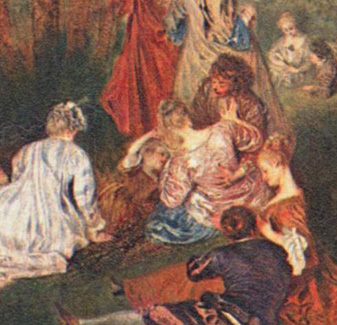
- Home Page
- Accepted
Paintings & Copies - Doubtful
Attributions - Doubtful Textual References
- Alternative
Titles - Collectors &
Museums - Bibliography
- Search Abecedario
- Watteau &
His Circle
Le Faux pas
Entered May 2022
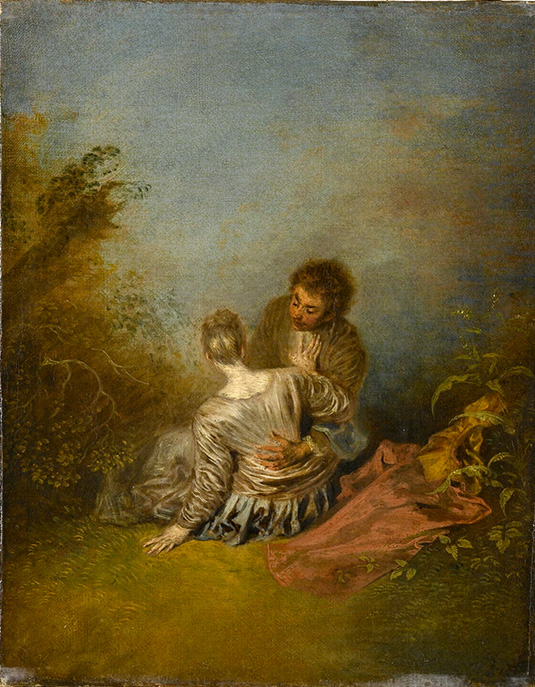
Paris, Musée du Louvre, inv. MI 1127
Oil on canvas
40 x 31.5 cm
ALTERNATIVE TITLES
The False Move
The False Step
Giovane coppia all’aperto
L’Heureuse chute
Les Heureux amants
Young Couple in the Open Air
Zärtliches Paar
RELATED PRINTS
Le Faux pas was not engraved for Jean de Jullienne’s Oeuvre gravé.
PROVENANCE
Paris, collection of Jules Robert Auguste (1789-1850; painter and sculptor). His sale May 28-31, 1850, lot 63: “WATTEAU . . . Les heureux Amants. Paysage.” Bought for 825 francs by Dr. La Caze.
Paris, collection of Dr. Louis La Caze (1798-1869; physician); his collection was donated to the Musée du Louvre in 1869.
EXHIBITIONS
Paris, Galerie Martinet, Collectionsd’amateurs (1860), cat. 275 (as by Watteau, L’Heureuse chute, lent by M. Lacaze).
San Francisco, Palace of the Legion of Honor, Rococo Masterpieces (1949), cat. 51(as by Watteau, Le Faux pas, lent by the Musée du Louvre).
Washington, Paris, Berlin, Watteau 1684-1721 (1984), cat. 57 (as by Watteau, The Faux-pas, lent by the Musée du Louvre).
Faroult and Eloy, La Collection La Caze (2007), 72, 74, 114, 194. 44
Paris, Louvre, Corps en movement (2017), 31.
SELECT BIBLIOGRAPHY
Thoré-Bürger, “Exposition de tableaux” (1860), 273.
Gautier, “Ancienne école française” (1860), 1065.
Lejeune, Guide théorique et pratique (1863-65), I: 323.
Cousin, Le Tombeau de Watteau (1865), 29.
Mantz, “La Collection La Caze” (1870), 12.
Paris, Louvre, Tableaux légués par M. La Caze (1871), cat. 266.
Goncourt, Catalogue raisonné (1875), 165.
Dohme, “Die Ausstellung” (1883), 232, 233.
Mollet, Watteau (1883), 73.
Mantz, Watteau (1892), 152.
Phillips, Watteau (1895), 56.
Fourcaud, “L’Existence de Watteau” (1901), 257.
Staley, Watteau (1902), 128.
Marcel, “Une Oeuvre de Watteau” (1904), 377.
Pilon, Watteau et son école (1912), 50, 89, 114, 121.
Zimmermann, Watteau (1912), 178-79, no. 83.
Pilon, Watteau et son école (1912), 50, 89, 114, 121.
Dacier, Vuaflart, and Hérold, Jean de Jullienne et les graveurs (1921-29), 1: 164, 259.
Brière, Louvre, catalogue de peintures (1924), cat. 989.
Réau, “Watteau” (1928), cat. 135.
Brinckmann, Watteau (1943), 29, 60.
Adhémar, Watteau (1950), cat. 189.
Mathey, Watteau, peintures réapparues (1959), 68.
Macchia and Montagni, L’opera completa di Watteau (1968), cat. 172.
Béguin and Constans, “Le docteur La Caze” (1969), 7.
Ferré, Watteau (1972), cat. B 59.
Compin and Reynaud, Catalogue des peintures (1972) 1: 399.
Boerlin-Brodbeck, Watteau und das Theater (1973), 200. 225, 342.
Bazin, “Enquête sur Watteau” (1974), 61.
Paris, Louvre, Catalogue illustré (1974), cat. 923.
Cailleux, “Un Étrange monument” (1975), 248.
Hercenberg, Vleughels (1975), under cat. 139.
Posner, Review of Ferré, Watteau (1975), 292.
Banks, Watteau and the North (1977), 129, 190-91.
Bauer, Rokokomalerei (1980), 30.
Roland Michel, Watteau (1981), cat. 238.
Posner, Watteau (1984), 169, 173.
Roland Michel, Watteau (1984), 269.
Mathey, Watteau, peintures réapparues (1959), 68.
Compin and Roquebert, Catalogue sommaire illustré (1986), 286.
Rosenberg and Prat, Watteau, Catalogue raisonné des dessins (1996), 2: cat. 525, 599.
Temperini, Watteau (2002), 92, cat. 84.
Faroult and Eloy, La Collection La Caze (2007), 688, 689.
Michel, Le «célèbre Watteau» (2008), 204, 227.
Glorieux, Watteau (2011), 151.
Faroult, Vogtherr, and Preti-Hamard, Delicious Decadence (2014), 22.
RELATED DRAWINGS
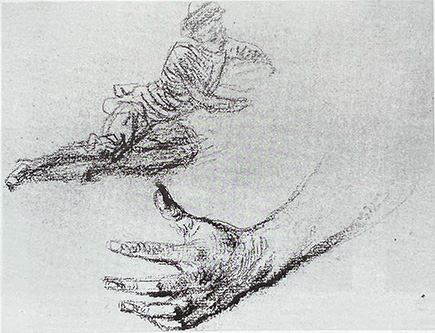
Watteau, Studies of a Reclining Man and a Hand, red, black, and white chalk, 11.5 x 15.1 cm. Whereabouts unknown.
Only one drawing has been associated with Le Faux pas, a quick study of a man reclining on the ground and a more carefully delineated study of a hand (Rosenberg and Prat 525). The study of the hand was supposedly used for the man’s hand supporting the woman’s back.
REMARKS
Although there is no trace of the painting before the mid-nineteenth century, and though it was not recorded in Jean de Jullienne’s Oeuvre gravé, almost no Watteau scholar has doubted the attribution of this picture to Watteau. The one notable exception is Germain Bazin but he also rejected some of the other fundamental works in Watteau’s oeuvre. Bazin aside, this relatively small and minor work has in its own right become an almost iconic representative of Watteau’s art, even though it lacks the depth of feeling and intimacy of Watteau’s more complex fêtes galantes.
Much has been written about the subject, which is somewhat ambiguous. Had it been engraved and given a title, perhaps our understanding of the narrative would be clearer but even then, the titles that were assigned are not meaningful or appropriate to the pictures. When this painting first reappeared in the mid-nineteenth century it was consistently referred to as L’Heureuse chute (The Lucky Fall). The title of Le Faux pas first appeared in the Louvre’s 1875 catalogue and then gradually became dominant. But did the woman make a misstep and fall, and does this imply a social mistake as some would read the painting?
The same pair in the same positions also appear in Watteau’s Fête d’amour in Dresden, where there is no innuendo that she fell. Indeed, there would have been no space for her to have been walking around. Rather, in both pictures it appears that the woman had been sitting on the ground and is now preparing to stand up. As she rises, she uses her right hand to brace herself against her companion, and with her left hand to push herself up. So too the man tenderly reaches behind her to assist her arising.
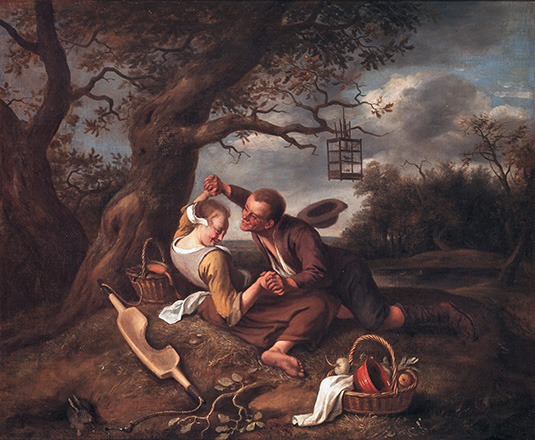
Jan Steen, Merry Couple, c. 1660, oil on canvas, 66 x 80.5 cm. Leyden, Museum De Lakenhal.
Much depends on the eye of the beholder. Brinckmann titled the painting Ein zärtliches Paar, that is, An Affectionate Couple. At the other extreme, Posner, who consistently sought to emphasize the erotic quality of Watteau’s art, compared Watteau’s couple to a grappling peasants painted by Jan Steen, in which the man is the aggressor. Far from Watteau’s intention in Le Faux pas, this proposed comparison may tell us more about the critic than the artist.
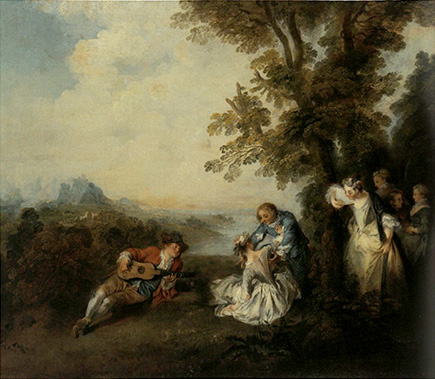
Nicolas Lancret, Company at the Edge of a Forest, oil on canvas, 64 x 79 cm. Moscow, Pushkin Museum.
Because Watteau is such a talented artist and because Le Faux pas enjoys a position of prominence in the Louvre’s collection, it has attracted undue speculation. On the other hand, a quite similar couple appears in the works of Watteau’s followers, such as an intimate fête galante by Lancret in the Pushkin Museum where a woman seated on the ground starts to arise, bracing herself against her male companion and pushing back with the other hand. The narrative in Lancret’s picture is straightforward and reasonable, and this should apply to Watteau’s picture as well.
Did Le Faux pas precede or follow La Fête d’amour? With most other artists one would be tempted to presume that the smaller, simpler version came first and then evolved into the second, fuller rendering. Yet this was evidently not Watteau’s working method. For example, his Bon voyage might seems to be a preliminary idea for the more complex Le Pelerinage à l’ile de Cythère. but the reverse is true; it is an excerpt from the earlier, larger composition. The curious thing is that Le Faux pas is twice the size of the figures in La Fête d’amour. Here he worked from small to large.
Essentially, both the lower and upper regions of Le Faux pas are voids. One could easily imagine an oval frame encircling these areas—much as in Le Rendez-vous and Le Mezzetin in the Metropolitan Museum.
Most scholars date Le Faux pas to the latter part of Watteau’s career, and in relation to La Fête d’amour. Mathey opted for c. 1716, the Louvre dates its painting c. 1716-18; Macchia and Montagni preferred 1717, Adhémar and Glorieux favored 1717-18, and Roland Michel, Temperini, and Faroult and Eloy have proposed c. 1718-19, which is the latest date that has been suggested. Rosenberg and Prat would date the one drawing associated with the painting (Rosenberg and Prat 525) to c. 1717, which means that they too favor a late dating for the work.
Click here for copies of Le Faux pas
